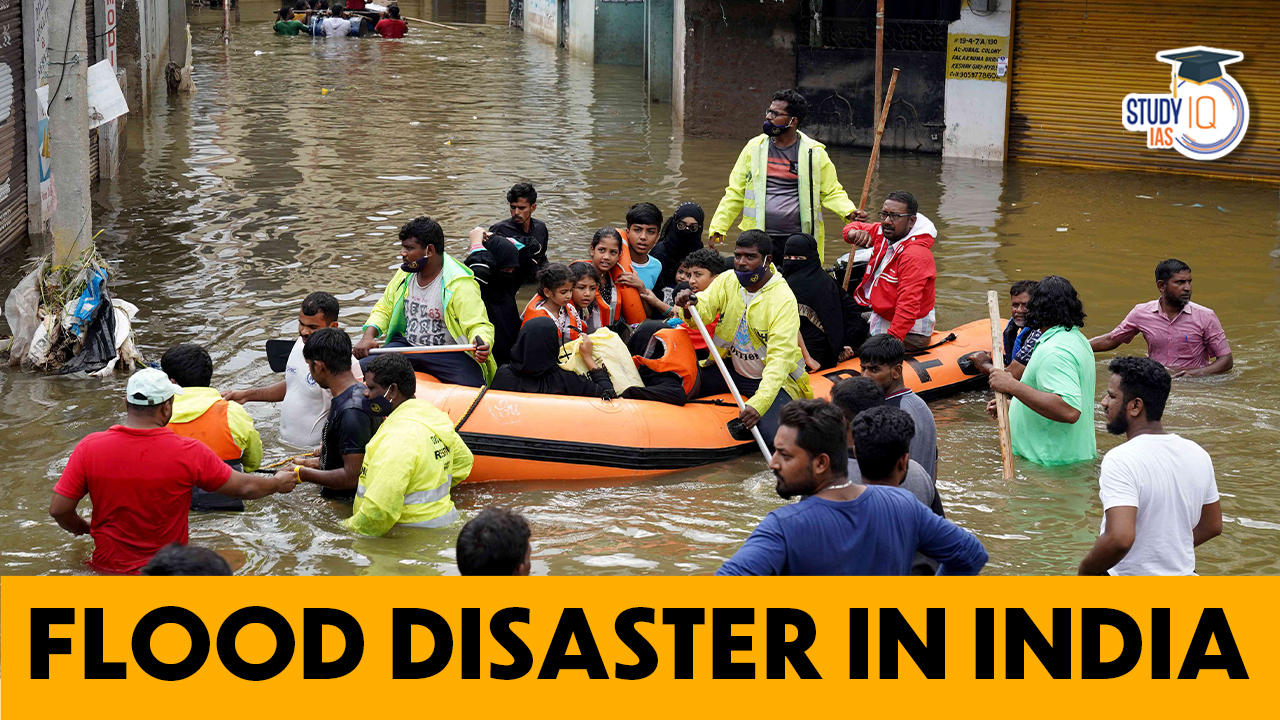Table of Contents
Flood Disaster in India
India is extremely susceptible to flooding. Over 40 million hectares (mha) of the 329 million hectares (mha) total geographic area are at risk of flooding. Floods are a frequent occurrence that result in significant human casualties as well as damage to property, infrastructure, and public services. The fact that flood-related damages are on the rise is cause for alarm.
In the past ten years, from 1996 to 2005, the average yearly flood damage was Rs. 4745 crore, compared to Rs. 1805 crore, the corresponding average for the prior 53 years. Numerous factors, such as a sharp rise in population, fast urbanization, an increase in economic and development activity in flood plains, and global warming, might be blamed for this.
Flood Zone Map
Punjab, Haryana, the majority of the Gangetic plains, including Uttar Pradesh, North Bihar, and West Bengal, the Brahmaputra valley, coastal Andhra Pradesh and Orissa, and southern Gujarat are the primary flood zone in India. Kerala and Tamil Nadu are currently experiencing the full force of the floods. In September 2014, the Indian-administrated Jammu and Kashmir territory saw catastrophic flooding that affected the majority of its districts. Devastating floods and landslides were created in June 2013 by a multi-day cloudburst that was centered on the state of Uttarakhand in northern India. Check the Flood Zone in India below:

What is Flood?
Flood is a state of high-water level along a river channel or on the coast that leads to inundation of land. Floods are commonly associated with a stream or river. A stream floods when its discharge is greater than the capacity of its river channel. Excess water flows over the riverbanks and submerges the adjacent land which is usually dry. When it happens, the channel and the flood plain together allow passage of water.

Flood in India 2023
Heavy rainfall during the 2023 monsoon season resulted in severe flooding and landslides across Northern India, primarily affecting residents in Himachal Pradesh, Punjab, Chandigarh, Uttarakhand, Jammu and Kashmir, Haryana, Rajasthan and Delhi. A monsoon surge, coupled with a western disturbance has led to the highest rainfall in decades in some parts of the region, causing nearby rivers to overflow, with flooding and landslides washing away vehicles, destroying bridges and roads, and disrupting power and electricity.
Over 100 individuals across Himachal Pradesh, Uttar Pradesh, and Delhi, have died over a two-week period of intense rain and flooding, with thousands of others evacuated to relief camps. The states of Rajasthan, Punjab, and Haryana experienced extensive waterlogging due to heavy rainfall.
Causes of Floods
The causes of flood can be classified into two types first the Natural causes and second is the Anthropogenic Causes. The natural causes have been mentioned below:
Heavy rainfall
Heavy rain in the catchment area of a river causes water to overflow its banks, which results in the flooding of nearby areas. The Assam floods are due to heavy rainfall in a short period of time.
Snow melt
Snowmelt and glacial melt are gradual processes and usually does not cause major floods. But sometimes glaciers hold large quantity of bounded water, which may be suddenly released with melting of ice block resulting into Glacial Lake Outburst Floods (GLOFs). In June 2013, flashfloods in Uttarakhand that wiped out settlements and decimated lives are attributed to a GLOF in the Chorabari glacier.
Sediment deposition
Riverbeds become shallow due to sedimentation. The water carrying capacity of such river is reduced. As a result, the heavy rainwater overflows the river banks. Frequent floods were observed in 2003, 2008, 2011, and 2013 near the deltaic region of the Mahanadi River due to the excessive sediment deposition.
Tropical cyclones and hurricanes
These powerful weather systems often bring heavy rainfall and storm surges, resulting in widespread flooding in coastal and low-lying areas. In 2019, Cyclone Fani hit the eastern coast of India, resulting in heavy rainfall and storm surges.
Change in the course of the river
Meanders, erosion of riverbeds and banks, and obstruction of flow due to landslides also lead to changes in river courses. The 2008 Kosi River flood resulted from heavy rainfall and a subsequent course change, leading to catastrophic flooding, displacement of thousands, and widespread damage in Bihar, India.
Tsunami
Large coastal areas are flooded by rising sea water, when a tsunami strikes the coast.
Lack of Lakes
Lakes can store the excess water and regulate the flow of water. When lakes become smaller, their ability to regulate the flow become less and, hence flooding.
The Anthropogenic Causes has been discussed below:
Deforestation
The removal of trees and vegetation reduces the natural absorption of rainfall, leading to increased surface runoff and a higher likelihood of flooding. The devastating floods that hit the state of Kerala in 2018 were partially attributed to deforestation, as the loss of forest cover reduced the natural water-holding capacity of the region.
Urbanization
Construction of buildings, roads, and other infrastructure reduces natural permeable surfaces, which can exacerbate surface runoff and overwhelm drainage systems. Chennai experienced severe flooding in 2015 due to heavy rainfall combined with unplanned urbanization. The city’s drainage systems were overwhelmed, resulting in widespread inundation and disruption.
Land use changes
Alterations in land use, such as converting natural wetlands into agricultural or urban areas, can disrupt natural water retention and drainage patterns, increasing the risk of flooding.
Dam failures
Structural failures or breaches in dams and reservoirs can release large volumes of water downstream, causing severe flooding. In 2019, the collapse of the Tiware Dam in Maharashtra caused flash floods in downstream villages.
Interference in drainage system
Drainage congestion caused by badly planned construction of bridges, roads, railway tracks, canals etc. hampers the flow of water and results in floods.
Flood Vulnerability in India
- As per the Geological Survey of India (GSI), over 40 million hectares which is nearly 12 % of the total land area of India is prone to floods.
- India receives an annual rainfall of 1200 mm, 85% of which is concentrated in 3-4 months i.e., June to September. Due to the intense and periodic rain, most of the rivers are fed with huge quantity of water, much beyond their carrying capacity leading to mild to severe flood situations in the region.
- The major flood areas in India are in the Ganges – Brahmaputra – Meghna Basin which accounts for nearly 60% of the total river flow of the country.
Distribution of Flood Prone Areas in India
The flood prone areas of India are distributed across four major regions. They are:
| Distribution of Flood Prone Areas in India | |
| Flood Prone Areas | Details |
| The Brahmaputra River Region |
|
| The Ganga River Region |
|
| The North-West River Region |
|
| The Central and Deccan India |
|
Floods in India in Last 5 years
This is a list of significant floods that have been documented in India. In India, floods are the most frequent natural calamity. The Brahmaputra, one of the heavier southwest rivers, as well as other rivers, often cause nearby communities to flood. Check the flood disaster from 2018 to 2023.
Kerala Flood in 2018 and 2019
Kerala experienced a 23% overflow of the southwest monsoon in 2018, and August saw 96% above-average rainfall. Kerala, India, experienced significant rainfall on August 8 in the middle of the evening that was 116% over average, causing dams to overflow. The state received 310 mm (12 in) of rain over the last 48 hours. Since the water level had increased to almost overflow level as a result of severe rain, flooding nearby low-lying areas, nearly all dams had been opened. 35 of the state’s 54 dams have been opened for the first time ever. The leveling of wetlands is thought to be one cause. It has been said that the flood was a result of global warming.
Kerala was severely flooded on August 8, 2019, as a result of the monsoon season’s abundant rainfall. A low that tossed the Arabian Sea caused heavy convection over Kerala, which led to the severe rains. To safer locations and relief camps, thousands of people have been evacuated. As of August 19th, 2019, 121 persons had lost their lives as a result of rain-related incidents.
Assam Flood in 2020
The state of Assam is susceptible to yearly flooding because of its tropical monsoon environment. The COVID-19 pandemic and the large flood of the Brahmaputra River in the Indian state of Assam are referred to as the “2020 Assam Floods.” Heavy rains in May 2020 caused the first floods, which affected 30,000 people and destroyed crops in five regions.
Uttarakhand Flood in 2021
The Chamoli tragedy, also known as the 2021 Uttarakhand flood, started on February 7, 2021, near the Nanda Devi National Park, a UNESCO World Heritage Site in the outer Garhwal Himalayas of Uttarakhand state, India. It was brought on by a massive rock and ice avalanche that was triggered by debris that was displaced from Ronti mountain. The Rishiganga, Dhauliganga, and Alaknanda rivers—the main headstream of the Ganges—all experienced floods in the Chamoli area as a result. Over 200 people were murdered or missing as a result of the catastrophe. Most were laborers at the Tapovan dam construction site.
Assam Floods in 2022
One of the worst floods Assam has ever experienced occurred in 2022, lasting over 7 months (from April to October 2022) in a series of waves. The Pre-Monsoon Rains, which began in the state on April 6, 2022, and the Monsoon Season that followed are the main contributors to the floods. A total of 5.6 million people were impacted, 4.7 million were displaced, 108,308 hectares of cropland were devastated, 3,660,173 animals were impacted, and 32 districts in the state were affected.
North India Flood in 2023
In Northern India, the monsoon season of 2023 brought about severe flooding and landslides that predominantly affected the people living in Himachal Pradesh, Punjab, Chandigarh, Uttarakhand, Jammu and Kashmir, Haryana, Rajasthan, and Delhi. The heaviest rainfall in certain parts of the region in decades has been brought on by a monsoon surge and a western disturbance. This has caused local rivers to overflow, flooding and landslides to demolish bridges and roads, wash away cars, and impair power and electricity.
Consequences of Floods
- Loss of life and injuries: Floods can result in the loss of human lives and cause injuries, especially when people are caught unaware or unable to evacuate in time.
- Damage to infrastructure: Floodwaters can cause severe damage to roads, bridges, buildings, and other infrastructure. This damage can disrupt transportation networks, communication systems, and essential services, making rescue and relief operations challenging.
- Displacement and homelessness: Floods often force people to evacuate their homes and seek shelter in temporary accommodations or relief camps.
- Impact on agriculture and food security: Floods can devastate agricultural lands and crops, destroy livestock leading to significant losses in the agricultural sector.
- Water contamination and health risks: Spread of diseases like cholera, gastro-enteritis, hepatitis and other water-borne diseases spread in the flood-affected areas.
- Environmental damage: Floods can cause erosion, sedimentation, and the destruction of natural habitats.
- Soil fertility: Floods also make a few positive contributions. Every year, flood deposit fertile silt over agricultural fields which restores fertility of the soil.
Flood Prevention and Mitigation
Structural Measures
- Dams and Reservoirs: Construction of dams and reservoirs to store excess water during heavy rainfall and release it in a controlled manner, reducing downstream flood risk.
- Levees and Floodwalls: Building embankments, levees, and floodwalls along rivers and coastlines to contain floodwaters and protect adjacent areas from inundation.
- Flood Diversion Channels: Creation of diversion channels or canals to redirect excess water away from vulnerable areas, reducing flood impact.
- Flood Control Basins: Designing flood control basins or detention ponds to temporarily store and regulate floodwaters, preventing their rapid downstream flow.
- Channelization: Modifying and straightening river channels to improve their flow capacity and efficiency, reducing the risk of overflow and flooding.
- Floodplain Restoration: Restoring natural floodplains by removing obstructions, reconnecting floodplain habitats, and creating additional space for water storage during floods.
Non-Structural Measures:
- Floodplain Zoning and Land Use Planning: Implementing zoning regulations that restrict construction in high-risk floodplain areas, ensuring that development is appropriately located and mitigating potential flood damage.
- Early Warning Systems: Establishing robust early warning systems that use technology and community engagement to provide timely alerts and evacuation guidance to vulnerable populations.
- Flood Insurance and Financial Mechanisms: Promoting the availability of flood insurance to incentivize risk reduction measures and provide financial protection to individuals and businesses affected by floods.
- Public Awareness and Education: Conducting public awareness campaigns to educate communities about flood risks, safety measures, and preparedness strategies, fostering a culture of resilience.
- Urban Drainage Systems: Developing and maintaining efficient stormwater drainage systems in urban areas to manage excess rainfall and prevent waterlogging and urban flooding.
- Ecosystem-Based Approaches: Preserving and restoring natural ecosystems, such as wetlands and mangroves, which act as natural buffers and absorb floodwaters, reducing flood impacts.
- Integrated Water Resources Management: Adopting an integrated approach to water resources management that considers the entire watershed, balancing water allocation, flood control, and environmental sustainability.


 UPSC CMS Salary 2024, In Hand Salary, St...
UPSC CMS Salary 2024, In Hand Salary, St...
 UPSC CMS Syllabus 2024, Check Exam Patte...
UPSC CMS Syllabus 2024, Check Exam Patte...
 How to Prepare for UPSC in 6 Months?
How to Prepare for UPSC in 6 Months?

















